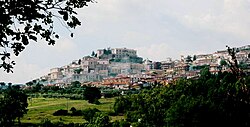Gesualdo, Campania
| Gesualdo | |
|---|---|
| Comune | |
 |
|
| Location of Gesualdo in Italy | |
| Coordinates: 41°00′N 15°04′E / 41.000°N 15.067°ECoordinates: 41°00′N 15°04′E / 41.000°N 15.067°E | |
| Country | Italy |
| Region | Campania |
| Province / Metropolitan city | Avellino (AV) |
| Government | |
| • Mayor | Domenico Forgione (since May the 27th, 2013) |
| Area | |
| • Total | 27 km2 (10 sq mi) |
| Elevation | 640 m (2,100 ft) |
| Population (December 31, 2004) | |
| • Total | 3,828 |
| • Density | 140/km2 (370/sq mi) |
| Demonym(s) | Gesualdini |
| Time zone | CET (UTC+1) |
| • Summer (DST) | CEST (UTC+2) |
| Postal code | 83040 |
| Dialing code | 0825 |
| Patron saint | St. Nicholas |
| Saint day | December 6th |
| Website | Official website |
Gesualdo is an Italian town in the region of Campania, province of Avellino, with about 3,800 inhabitants. It is called "The City of the Prince of Musicians," in honour of Carlo Gesualdo. It has many buildings, fountains, great belvederes, a beautiful old town, which was partially restored after the Irpinia earthquake in 1980.
The town is located in the middle of Irpinia, between the valleys of the rivers Fredane and Ufita. It is about 90 kilometres (56 mi) from Naples and 290 kilometres (180 mi) from Rome. Surrounding municipalities are Fontanarosa, Frigento, Grottaminarda, Paternopoli, Villamaina.
How to reach it: The town is 9 kilometres (6 mi) from A16 (Autostrada Napoli - Bari), exit "Grottaminarda".
The Southern exposure on the right side of the valley of river Fredane, a tributary of river Calore Irpino, made Gesualdo inhabited since the prehistoric times.
In Roman times villas were located in the areas of Toppolo San Barbato, Paolino, Volpito and Pastene.
The foundation of the current town, which became the capital of an important wide fief, coincides with the erection of a fortress around which houses and houses have been added during the centuries. The fortress was owned in AD 660 by Gesualdo, a Lombard knight who gave his life to defend Romuald, Duke of Benevento, during the war against the Byzantines.
Gesualdo's descendants had been lords of the area for four hundred years and depended on the Duke of Benevento until the Norman conquest (eleventh century).
The Norman dynasty began with Guglielmo, King Roger the Norman's illegitimate child. On his death, his son Elia became Second Lord of Gesualdo. Elia's reign was the period of greatest expansion for the Fief of Gesualdo, which extended its domain to over thirty sites. Ruggero, Elia's son became Third Lord of Gesualdo, and his brother, Roberto, was the first to assume the surname Gesualdo, in honour of the Lombard founder of the manor. After Ruggero, German lords owned Gesualdo, but soon Elia Gesualdo the 2nd, Roberto's son, took possession of the manor again and became Fourth Lord of Gesualdo. On Elia the 2nd's death, his son Nicolò the 1st became Fifth Lord of Gesualdo. He participated in the war that King Charles the 2nd of Anjou made to obtain Sicily and he also was named Captain of the City of Naples. He had no sons. That's why the manor passed to one of his daughters and her offspring. During this period the Celestine Monastery, which currently houses the Town Hall, was founded in Gesualdo. The fief came back to the Gesualdos with Mattia Gesualdo the 2nd, Sixth Lord of Gesualdo, who was the grandson of Nicolò the 1st's brother. In the second half of the fifteenth century, Gesualdo and his castle were often subject to warlike actions. In the sixteenth century several noblemen became lords of Gesualdo by hereditary right: Lionetto, Sansonetto, Luigi the 2nd (who obtained the title of Count of Conza), Nicolò the 4th, Luigi the 3rd, Fabrizio the 1st, Luigi the 4th (who even obtained the title of Prince of Venosa), Fabrizio the 2nd, and finally Carlo Gesualdo (1566-1613), who was Fifteenth Lord of Gesualdo, Sixth Count of Conza, Third Prince of Venosa, and the last and most famous lord of the family. Prince Carlo gave luster to the town. He transformed the castle from a rude fortress into a refined palace, which was able to accommodate a sumptuous court: writers and poets, like Torquato Tasso, were regulars at the castle, where Carlo composed a great number of his madrigals. He also built three churches and two monasteries, one for the Dominicans and one for the Capuchins.
...
Wikipedia

